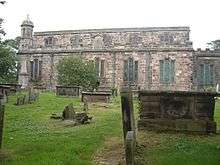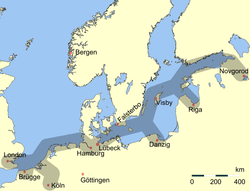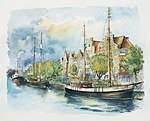Berwick-upon-Tweed
Berwick-upon-Tweed (/ˌbɛrɪk-/ (![]()
| Berwick-upon-Tweed | |
|---|---|
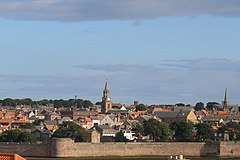 View over Berwick-upon-Tweed town centre | |
 Berwick-upon-Tweed Location within Northumberland | |
| Population | 12,043 (2011 Census) |
| OS grid reference | NT995525 |
| • London | 345 mi (555 km) |
| Civil parish |
|
| Unitary authority | |
| Ceremonial county | |
| Region | |
| Country | England |
| Sovereign state | United Kingdom |
| Post town | Berwick-upon-Tweed |
| Postcode district | TD15 |
| Dialling code | 01289 |
| Police | Northumbria |
| Fire | Northumberland |
| Ambulance | North East |
| UK Parliament | |
| Website | Berwick-upon-Tweed Town Council |
The 2011 United Kingdom census recorded Berwick's population as 12,043.[2] A civil parish and town council were formed in 2008 comprising the communities of Berwick, Spittal and Tweedmouth.[3]
Berwick was founded as an Anglo-Saxon settlement during the time of the Kingdom of Northumbria, which was annexed by England in the 10th century.[4]
The area was for more than 400 years central to historic border wars between the Kingdoms of England and Scotland, and several times possession of Berwick changed hands between the two kingdoms. The last time it changed hands was when Richard of Gloucester retook it for England in 1482.[5] To this day many Berwickers feel a close affinity to Scotland.[6]
Berwick remains a traditional market town and also has some notable architectural features, in particular its medieval town walls, its Georgian Town Hall, its Elizabethan ramparts, and Britain's earliest barracks buildings, which Nicholas Hawksmoor built (1717–21) for the Board of Ordnance.[7]
Name
The name "Berwick" is of Old English origin, and is derived from the term bere-wīc,[8] combining bere, meaning "barley", and wīc, referring to a farm or settlement. "Berwick" thus means "barley village" or "barley farm".[9][10]
Alternative etymologies, including ones connecting the name with the Anglo-Saxon kingdom Bernicia, and the Brythonic element aber, meaning 'estuary, confluence', have also been suggested.[11]
History
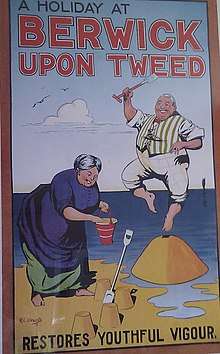
Early history
In the post-Roman period, the area was inhabited by the Brythons of Bryneich. Later, the region became part of the Anglian kingdom of Bernicia. Bernicia later united with the kingdom of Deira to form Northumbria, which in the mid-10th century entered the Kingdom of England under Eadred.[12][13]
Berwick remained part of the Earldom of Northumbria until control passed to the Scots following the Battle of Carham of 1018. The town itself was founded as an Anglo-Saxon settlement during the time of the Kingdom of Northumbria.[4]
Scottish burgh
Between the late 10th and early 11th centuries, the land between the rivers Forth and Tweed came under Scottish control, either through conquest by Scotland or through cession by England.[14] Berwick was made a royal burgh in the reign of David I.[15] A mint was present in the town by 1153.[16] In 1276, William de Baddeby was Constable of Berwick.[17] It is unclear if this relates to the walled town itself, or the castle.
While under Scottish control, Berwick was referred to as "South Berwick" in order to differentiate it from the town of North Berwick, East Lothian, near Edinburgh.[18]
Berwick had a mediaeval hospital for the sick and poor which was administered by the Church. A charter under the Great Seal of Scotland, confirmed by King James I of Scotland, grants the king's chaplain "Thomas Lauder of the House of God or Hospital lying in the burgh of Berwick-upon-Tweed, to be held to him for the whole time of his life with all lands, teinds, rents and profits, etc, belonging to the said hospital, as freely as is granted to any other hospital in the Kingdom of Scotland; the king also commands all those concerned to pay to the grantee all things necessary for the support of the hospital. Dated at Edinburgh June 8, in the 20th year of his reign."
Disputed territory
Berwick's strategic position on the Anglo-Scottish border during centuries of war between the two nations and its relatively great wealth led to a succession of raids, sieges and takeovers. William I of Scotland invaded and attempted to capture northern England in 1173–74.[19] After his defeat, Berwick was ceded to Henry II of England.[20] It was later sold back to William by Richard I of England in order to raise funds for his Crusade.[21]
Berwick had become a prosperous town by the middle of the 13th century. According to William Edington, a bishop and chancellor of England, Berwick was "so populous and of such commercial importance that it might rightly be called another Alexandria, whose riches were the sea and the water its walls".[22]
In 1291–92, Berwick was the site of Edward I of England's arbitration in the contest for the Scottish crown between John Balliol and Robert Bruce, 5th Lord of Annandale.[23] The decision in favour of Balliol was pronounced in the Great Hall of Berwick Castle on 17 November 1292.[23]
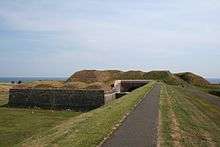
In 1296, England went to war with France, with which Scotland was in alliance. Balliol invaded England in response, sacking Cumberland.[24] Edward in turn invaded Scotland and captured Berwick, destroying much of the town and massacring some 20,000 of the inhabitants.
Edward I went again to Berwick in August 1296 to receive formal homage from some 2,000 Scottish nobles, after defeating the Scots at the Battle of Dunbar in April and forcing John Balliol to abdicate at Kincardine Castle the following July. It was at this time that work began on building the town walls (and rebuilding the earlier Castle); these fortifications were complete by 1318 and subsequently improved under Scottish rule. An arm of William Wallace was displayed at Berwick after his execution and quartering on 23 August 1305. In 1314, Edward II of England mustered 25,000 men at Berwick, who later fought in (and lost) the Battle of Bannockburn. Between 1315-18, Scottish armies, sometimes with the help of Flemish and German privateers, besieged and blockaded the town, finally invading and capturing it in April 1318.[25]
England retook Berwick the day after the Battle of Halidon Hill in 1333.[26] In October 1357, a treaty was signed at Berwick by which the Scottish estates undertook to pay 100,000 marks as a ransom for David II of Scotland,[27] who had been taken prisoner at the Battle of Neville's Cross on 17 October 1346. In 1461, Berwick was ceded back to Scotland by Margaret of Anjou on behalf of her husband, Henry VI, in return for help against the Yorkists during the Wars of the Roses.[28]
Robert Lauder of Edrington was put in charge of the castle. He was succeeded in 1474 by David, Earl of Crawford. On 3 February 1478, Robert Lauder of the Bass and Edrington was again appointed Keeper of the castle, a position that he held until the final year of Scottish occupation, when Patrick Hepburn, 1st Lord Hailes, had possession.
In 1482, Richard, Duke of Gloucester (later Richard III) recaptured the town.[29] Thomas Gower (fl. 1543 – 1577) was the English marshal of Berwick 1543-1552. The Scots did not accept this conquest as is evidenced by innumerable charters for at least two centuries after this date.[17] Over the course of a little more than 400 years, Berwick had changed hands more than a dozen times.[30]
English town
In 1551, the town was made a self-governing county corporate. During the reign of Queen Elizabeth I of England, vast sums – one source reports "£128,648, the most expensive undertaking of the Elizabethan period"[31] – were spent on its fortifications, in a new Italian style (trace italienne), designed both to withstand artillery and to facilitate its use from within the fortifications. These fortifications have been described as "the only surviving walls of their kind".[13] Sir Richard Lee designed some of the Elizabethan works.[32]
Berwick’s role as a border fortress town ended with the Union of the Crowns of England and Scotland. On 6 April 1603, James VI of Scotland crossed the Border on his journey southwards to be crowned James I of England. He was met at Lamberton by the Lord Governor of Berwick with a mounted party from the garrison and was conducted into the town. In December 1603, the Crown ordered the dissolution of the garrison of Berwick and the number of soldiers was reduced to 100 men and pensioners.[33]
In 1639, the army of Charles I faced that of General Alexander Leslie at Berwick in the Bishops' Wars, which were concerned with bringing the Presbyterian Church of Scotland under Charles's control. The two sides did not fight, but negotiated a settlement, the "Pacification of Berwick".[34]
Berwick Bridge, also known as the "Old Bridge" dates to 1611. It linked Islandshire on the south bank of the River Tweed with the county burgh of Berwick on the north bank.[35] Holy Trinity Church was built in 1648–52.[36] It is the most northerly parish church in England and was built under special licence from Oliver Cromwell during the Commonwealth period.[37]
The population of the parliamentary borough in 1841 was 12,578, and that of the parish was 8,484.[38]
British Town

In 1707, the Act of Union between England and Scotland largely ended the contention about which of the countries Berwick belonged to. Since then, Berwick remained within the laws and legal system of England and Wales. The Wales and Berwick Act 1746 (since repealed) deemed that whenever legislation referred to England it applied to Berwick.
In the 1840s, Samuel Lewis included similar entries for Berwick-upon-Tweed in both his England and Scotland Topographical Dictionary.[39] Berwick remained a county in its own right, and was not included in Northumberland for Parliamentary purposes until 1885. In the same year, the Redistribution of Seats Act reduced the number of Members of Parliament (MPs) returned by the town from two to one.
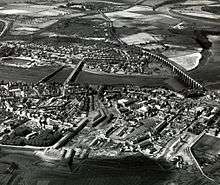
England now is officially defined as "subject to any alteration of boundaries under Part IV of the Local Government Act 1972, the area consisting of the counties established by section 1 of that Act, Greater London and the Isles of Scilly.",[40] which thus includes Berwick. In the 1972 act's reorganisation of English local government from 1 April 1974, the Borough of Berwick-upon-Tweed was created by the merger of the previous borough of Berwick-upon-Tweed with Belford Rural District, Glendale Rural District and Norham and Islandshires Rural District.
The Interpretation Act 1978 provides that in legislation passed between 1967 and 1974, "a reference to England includes Berwick upon Tweed and Monmouthshire".
In 2009 the Borough of Berwick-upon-Tweed was abolished as part of wider structural changes to local government in England. All functions previously exercised by Berwick Borough Council were transferred to Northumberland County Council, which is the unitary authority for the area.
Climate
Berwick-upon-Tweed has a typical British marine climate with narrow temperature differences between seasons. Because of its far northern position in England coupled with considerable North Sea influence, the area has very cool summers for an English location, with a subdued July (1981–2010) high of 17.9 °C (64.2 °F). January in turn has a high of 6.8 °C (44.2 °F) with a low of 1.7 °C (35.1 °F) with occasional frosts averaging 38.1 times per annum. Rainfall is relatively low by British standards, with 589.2 millimetres (23 3⁄16 in) on average; nonetheless, sunshine is limited to an average 1508.5 hours per annum. All data are sourced from the Berwick-upon-Tweed station operated by the Met Office.[41]
| Climate data for Berwick-upon-Tweed 22 m (72 ft) asl, 1981–2010 | |||||||||||||
|---|---|---|---|---|---|---|---|---|---|---|---|---|---|
| Month | Jan | Feb | Mar | Apr | May | Jun | Jul | Aug | Sep | Oct | Nov | Dec | Year |
| Average high °C (°F) | 6.8 (44.2) |
7.1 (44.8) |
8.8 (47.8) |
10.4 (50.7) |
13.4 (56.1) |
15.6 (60.1) |
17.9 (64.2) |
17.6 (63.7) |
16.0 (60.8) |
12.8 (55.0) |
9.3 (48.7) |
6.9 (44.4) |
11.9 (53.4) |
| Daily mean °C (°F) | 4.3 (39.7) |
4.5 (40.1) |
6.0 (42.8) |
7.4 (45.3) |
10.0 (50.0) |
12.5 (54.5) |
14.7 (58.5) |
14.4 (57.9) |
12.7 (54.9) |
9.8 (49.6) |
6.7 (44.1) |
4.4 (39.9) |
9.0 (48.1) |
| Average low °C (°F) | 1.7 (35.1) |
1.8 (35.2) |
3.1 (37.6) |
4.4 (39.9) |
6.6 (43.9) |
9.4 (48.9) |
11.4 (52.5) |
11.2 (52.2) |
9.4 (48.9) |
6.7 (44.1) |
4.1 (39.4) |
1.8 (35.2) |
6.0 (42.8) |
| Average rainfall mm (inches) | 45.0 (1.77) |
35.9 (1.41) |
42.1 (1.66) |
35.8 (1.41) |
47.1 (1.85) |
47.3 (1.86) |
61.2 (2.41) |
59.4 (2.34) |
54.5 (2.15) |
59.1 (2.33) |
54.3 (2.14) |
47.4 (1.87) |
589.2 (23.20) |
| Average rainy days | 11.1 | 8.8 | 10.0 | 9.8 | 8.8 | 8.6 | 9.7 | 10.6 | 9.2 | 13.4 | 12.5 | 11.1 | 123.6 |
| Mean monthly sunshine hours | 59.8 | 91.8 | 113.8 | 159.3 | 196.3 | 174.8 | 182.5 | 167.3 | 135.2 | 103.7 | 72.9 | 51.2 | 1,508.5 |
| Source: Met Office[41] | |||||||||||||
Governance
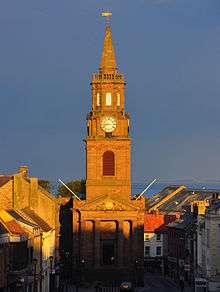
During periods of Scottish administration Berwick was the county town of Berwickshire, to which the town gave its name. Thus at various points in the Middle Ages and from 1482 (when Berwick became administered by England) Berwickshire had the unique distinction of being the only county in the British Isles to be named after a town in another country.[42]
The town of Berwick was a county corporate for most purposes from 1482, up until 1885, when it was fully incorporated into Northumberland. Between 1885, and 1974, Berwick (north of the Tweed) was a borough council in its own right, and then on 1 April 1974 it was merged with Belford Rural District, Glendale Rural District and Norham and Islandshires Rural District.
During these periods, Berwick Borough Council and Berwickshire County Council (or District Council) existed, both named after the same town, but covering entirely different areas.
The Borough of Berwick-upon-Tweed was abolished on 1 April 2009.[43] From that date, Northumberland County Council assumed its functions, and those of the other districts in its area, to become a unitary authority.
A new Berwick-upon-Tweed Town Council, a town council, has been created covering Berwick-upon-Tweed, Tweedmouth and Spittal. It has taken over the former Borough's mayoralty and regalia. The current Mayor, First Citizen and Council Chairman is councillor Gregah Roughead.[44]
Berwick-upon-Tweed is in the parliamentary constituency of Berwick-upon-Tweed.
Economy
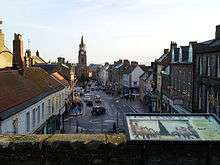
Slightly more than 60% of the population is employed in the service sector, including shops, hotels and catering, financial services and most government activity, including health care. About 13% is in manufacturing, 10% in agriculture, and 8% in construction. Some current and recent Berwick economic activities include salmon fishing, shipbuilding, engineering, sawmilling, fertilizer production, malting and the manufacture of tweed and hosiery.
Berwick town centre comprises the Mary Gate and High Street where many local shops and some retail chains exist. A new office development has been built in the Walker Gate beside the library which combined spaced with the Northumberland Adult Learning Centre and Tourism centre.[45]
There is a retail park in Tweedmouth consisting of a Home Base, Farm Foods, Marks and Spencer, Argos, Next, Carpet Right, Curry's PC World, Halfords, and the newly opened Pound Land. Berwick Borough Council refused a proposal from Asda in 2006 to build a store near the site,[46] but in 2008 gave Tesco planning permission for its new store in the town,[47] which opened on 13 September 2010. Asda went on to take over the Co-op shop unit in Tweedmouth early 2010. A Morrisons supermarket with a petrol station, alongside a branch of McDonald's, a Travelodge UK and an Aldi all exist on Loaning Meadows close to the outskirts of the town near the current A1.
Transport

The old A1 road passes through Berwick. The modern A1 goes around the town to the west. The town is on the East Coast Main Line railway, and is served by Berwick-upon-Tweed railway station. A small seaport at Tweedmouth facilitates the import and export of goods, but provides no passenger services. The port is protected by a long breakwater built in the 19th century, at the end of which is a red and white lighthouse. Completed in 1826, the 13-metre (43 ft) tower emits a white light every five seconds from a window overlooking the sea.[48] Seafarers' charity, Apostleship of the Sea has a chaplain to support the needs of mariners arriving at the port.[49]
Culture
Berwick's identity
Berwick is famous for its hesitation over whether it is part of Scotland or England.[50] Some people are adamant they are English and their loyalty lies with Northumberland, while others feel an affinity with Scotland.[51] However its close proximity to the Border means that the people of Berwick often have mixed Anglo-Scottish families and claim to be neither English nor Scottish, but simply "Berwickers".[52] Historian Derek Sharman said "The people of Berwick feel really independent. You are a Berwicker first, Scottish or English second."[53] Former mayor Mike Elliot said "25% of the town consider themselves English, 25% Scottish and 50% Berwickers."[54] Professor Dominic Watt of the University of Aberdeen noted that: "Older people view themselves more as Scots than the younger people in Berwick, and this can be heard in their accents."[55]
In 2008 SNP Member of Scottish Parliament (MSP) Christine Grahame made calls in the Scottish Parliament for Berwick to become part of Scotland again.[56] The Liberal Democrat MSP Jeremy Purvis, who was born and brought up in Berwick, asked for the border to be moved twenty miles south, stating: "There’s a strong feeling that Berwick should be in Scotland. Until recently, I had a gran in Berwick and another in Kelso, and they could see that there were better public services in Scotland."[57] However, Alan Beith, the former MP for Berwick, said the move would require a massive legal upheaval and is not realistic.[58] Beith's successor as MP, Anne-Marie Trevelyan, said: "Voters in Berwick-upon-Tweed do not believe it is whether they are in England or Scotland that is important."[53]
Berwick dialect
The local speech of Berwick-upon-Tweed shares many characteristics with both other rural Northumberland dialects and East Central Scots.[59][60] In 1892, linguist Richard Oliver Heslop divided the county of Northumberland into four dialect zones and placed the Berwick dialect in the "north-Northumbrian" region, an area extending from Berwick down to the River Coquet.[61] Likewise, Charles Jones (1997) classes the dialect as "predominantly North-Northumbrian" with "a few features shared with Scots".[62]
Features of this dialect include the "Northumbrian burr", a distinct pronunciation of the letter R historically common to many dialects of North East England; and predominant non-rhoticity: older speakers tend to be slightly rhotic, while younger speakers are universally non-rhotic.[63][64]
A sociological study of the Anglo-Scottish border region conducted in 2000 found that locals of Alnwick, 30 miles (50 kilometres) south of Berwick, associated the Berwick accent with Scottish influence. Conversely, those from Eyemouth, Scotland, 9 mi (14 km) north of Berwick, firmly classed Berwick speech as English, identifying it as "Northumbrian or Geordie".[65]
Sport
Berwick Rangers Football Club were formed in the town in 1881.[66] Despite being located in England, the club plays in the Scottish football league system. The home stadium of Berwick Rangers is Shielfield Park and the club currently plays in the Lowland League, the fifth tier of the Scottish football league system.
The town also has a rugby union side, Berwick RFC who play in Scottish Rugby Union's East Regional League Division 1.
Speedway has taken place in Berwick in two separate eras. The sport was introduced to Shielfield Park in May 1968. A dispute between the speedway club and the stadium owners ended the first spell. The sport returned to Shielfield Park in the mid-1990s. The lack of a venue in the town saw the team move to a rural location called Berrington Lough. The team, known as the Bandits, have raced at all levels from First Division to Conference League (first to third levels).
Tweedmouth Rangers Football Club have played in the East of Scotland Football League since 2016. Prior to this, they were members of the North Northumberland League. Their home ground is Old Shielfield Park, which the club uses under an agreement with the Berwick Rangers supporters club.
Berwick Rangers and Berwick RFC are unique in being English teams that play in Scottish leagues.[67]
Relations with Russia
There is an apocryphal story that Berwick is (or recently has been) officially at war with Russia.[68] According to a story by George Hawthorne in The Guardian of 28 December 1966, the London correspondent of Pravda visited the Mayor of Berwick, Councillor Robert Knox, and the two made a mutual declaration of peace. Knox said "Please tell the Russian people through your newspaper that they can sleep peacefully in their beds." The same story, cited to the Associated Press, appeared in The Baltimore Sun of 17 December 1966; The Washington Post of 18 December 1966; and The Christian Science Monitor of 22 December 1966. At some point in turn the real events seem to have been turned into a story of a "Soviet official" having signed a "peace treaty" with Mayor Knox; Knox's remark to the Pravda correspondent was preserved in this version.[68][69]
The basis for such status was the claim that Berwick had changed hands several times, was traditionally regarded as a special, separate entity, and some proclamations referred to "England, Scotland and the town of Berwick-upon-Tweed". One such was the declaration of the Crimean War against Russia in 1853, which Queen Victoria supposedly signed as "Victoria, Queen of Great Britain, Ireland, Berwick-upon-Tweed and all British Dominions". When the Treaty of Paris was signed to conclude the war, "Berwick-upon-Tweed" was left out. This meant that, supposedly, one of Britain's smallest towns was officially at war with one of the world's largest powers – and the conflict extended by the lack of a peace treaty for over a century.[69]
The BBC programme Nationwide investigated this story in the 1970s, and found that while Berwick was not mentioned in the Treaty of Paris, it was not mentioned in the declaration of war either. The question remained as to whether Berwick had ever been at war with Russia in the first place. The true situation is that since the Wales and Berwick Act 1746 had already made it clear that all references to England included Berwick, the town had no special status at either the start or end of the war. The grain of truth in this legend could be that some important documents from the 17th century did mention Berwick separately, but this became unnecessary after 1746.
Education
As with the rest of Northumberland, schools in Berwick use the three-tier system. Pupils may also commute across the Scottish border to Eyemouth or Berwickshire to attend secondary school.
First schools
- Berwick St Mary C of E
- Holy Island C of E
- Holy Trinity C of E
- Hugh Joicey C of E
- Lowick
- Norham St Celwulfs C of E
- Scremerston
- Spittal Community School
- St Cuthbert's RC
- Tweedmouth Prior Park
- Tweedmouth West
Middle schools
- Berwick Middle School
- Tweedmouth Community
High Schools
Independent schools
- Longridge Towers School (co-ed, all ages)
Special schools
- The Grove School
Twin towns


.svg.png)
.svg.png)

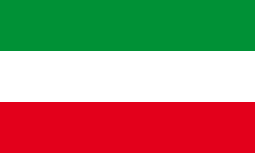


Landmarks
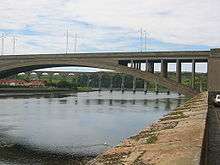
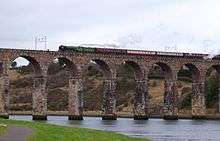
- Berwick Castle was built in the 13th century and rebuilt in the 1290s. It was in disrepair by the 17th century and much of it was demolished in the 19th century to make way for the railway. However, substantial ruins remain, just outside the town's rampart walls to the west by the river.
- Berwick town walls and Tudor ramparts – some of the finest remaining examples of their type in the country.
- The Old Bridge, 15-span sandstone arch bridge 355 metres (1,164 ft) long, built in 1610–24 for £15,000. The bridge continues to carry road traffic, but in one direction only. The bridge, part of the Great North Road from London to Edinburgh was built by order of James VI and I.
- Holy Trinity Parish Church, unusual for having been built during the Commonwealth of England. It was built in 1648–52 with stone from the 13th-century castle. It was originally a plain "preaching box", with no steeple, stained glass or other decorations. Contents include a pulpit thought to have been built for John Knox during his stay in the town. The church was much altered in 1855 with many new windows and the addition of a chancel.
- Berwick Barracks, built 1717–21, the design attributed to Nicholas Hawksmoor.
- The Town Hall, designed by S&J Worrell and built in 1754–60. The building is neoclassical and originally the town's prison was on the top floor. The tower above the council chamber has a ring of eight bells and a curfew bell. Lester and Pack of the Whitechapel Bell Foundry cast the tenor, third, fourth and treble bells in 1754 and the fifth and sixth bells in 1759. Charles Carr of Smethwick cast the second and curfew bells in 1894. Mears and Stainbank of the Whitechapel Bell Foundry cast the seventh bell in 1901.[70]
- Dewars Lane Granary, built in 1769, now restored as a hotel and art gallery.[71]
- Marshall Meadows Country House Hotel, built in 1780 as a country house, is north of the town. It is the most northern hotel in England, just 275 metres from the Scottish border at Marshall Meadows Bay.
- Union Bridge, 5 mi (8 km) upstream, from Berwick, was built in 1821 and is the world's oldest surviving suspension bridge.
- The Kings Arms Hotel on Hide Hill was built in 1782 and rebuilt in 1845. Charles Dickens stayed there in 1861.[72]
- The Royal Border Bridge, designed by Robert Stephenson and built in 1847–50 at a cost of £253,000, is a 720-yard-long railway viaduct with 28 arches, carrying the East Coast Main Line 126 feet above the River Tweed. It was opened by Queen Victoria.
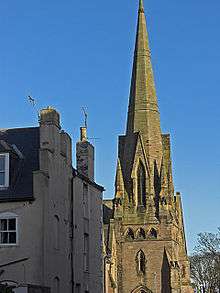
- St Andrew's Church, Wallace Green was built in 1859 and is one of only eight Church of Scotland congregations in England.
- The Masonic Hall was built in 1872 for the town's St David's Masonic Lodge for £1,800. The lodge still owns the hall, and is also used by other Masonic lodges and orders. It is one of very few purpose-built Masonic halls in the country and is a very rare example of Victorian Masonic architecture. It has a large pipe organ built in 1895. The Hall contains many artefacts and documents concerning Freemasonry in the town which can be traced back to 1643.
- The Royal Tweed Bridge, built in 1925 to carry the A1 road across the Tweed. Its span is 110 m (361 ft), which at the time was the longest concrete span. The A1 now bypasses the town to the west. In the early 2000s the bridge was renovated, the road and pavement layout revised and new street lighting added.
- Dewars Lane runs down Back Street just off Bridge Street. Like other Berwick locations it was painted by L. S. Lowry, who visited Berwick often, especially in the 1930s, when he stayed at the Castle Hotel.
- There are numerous sea caves on the coastline to the north of Berwick, with lengths up to 67 metres. The caves are found in the cliffs from Green's Haven to the Scottish border at Marshall Meadows Bay.[73]
Notable people
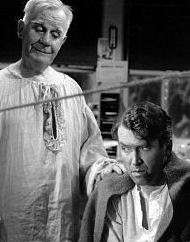
- Torben Betts, award-winning playwright, lives in Berwick
- Lucy Bronze, footballer for Olympique Lyon Women and England, born in Berwick-upon-Tweed
- James Cockburn, first speaker of the Canadian House of Commons, born in Berwick
- George Frederick Cooke (1756–1811), widely called the first Romantic actor in England
- Anne Hepple Dickinson (1877–1959), writer
- George Johnston (1797–1855), naturalist.
- Rev Prof Robert Lee DD (1804–1868), raised in Tweedmouth
- Eric Lomax, the author of The Railway Man, lived in Berwick-upon-Tweed
- Alan Martin, co-creator of the comic and movie character Tank Girl, lives in Berwick
- Jeremy Purvis, Liberal Democrat MSP, and youngest person in Scottish Parliament at time of election. Since 2013 Purvis has been a Life Peer in the House of Lords, sitting on the Liberal Democrat benches.
- James Redpath American anti-slavery activist and journalist, born in Berwick
- Ian Sarfas, English darts player played in the 1994 BDO World Darts Championships
- Thomas Smith, soldier and writer
- Trevor Steven, England and Everton footballer, born in Berwick
- Joseph Stevenson, prominent English Catholic archivist and Society of Jesus priest, born in Berwick
- Patrick Tonyn, born in Berwick in 1725, a military general and Governor of British East Florida
- Henry Travers, grew up in Berwick (although actually born in Prudhoe), was a character actor, most famously as Clarence the angel in It's a Wonderful Life
See also Berwick Castle for Governors of the castle and Berwick-upon-Tweed (UK Parliament constituency) for a list of former MPs.
See also
References
Footnotes
- Erlanger, Steven (13 September 2014). "Bracing for Change on Scotland's Border, Whatever the Referendum Result". The New York Times.
- "Area: Berwick-upon-Tweed (Parish): Key Figures for 2011 Census: Key Statistics". Neighbourhood Statistics. Office for National Statistics. Archived from the original on 4 March 2016. Retrieved 20 January 2015.
- "Parishing the Communities of Berwick, Spittal and Tweedmouth". Berwick-upon-Tweed Borough Council. Archived from the original on 27 September 2007.
- Lepage, Jean-Denis (2011). British Fortifications Through the Reign of Richard III. Jefferson, NC: McFarland & Co. p. 272. ISBN 978-0-7864-5918-6.
- Macdougall, Norman, James III, (1982), p. 169: Devon, Frederick, ed., Issues of the Exchequer, (1837), p. 501
- The Guardian. 27 January 2012. Would an independent Scotland be good for Northern England?
- Pevsner, Richmond & Grundy 1992
- Mills, A. D.; Room, Adrian (2003). A Dictionary of British Place-Names. Oxford: Oxford University Press. ISBN 978-0-19-852758-9.
- Room, Adrian (2005). Placenames of the World: Origins and Meanings of the Names for 6,600 Countries, Cities, Territories, Natural Features and Historic Sites. Jefferson, NC: McFarland & Co. p. 57. ISBN 978-0-7864-2248-7.
- Moffat, Alistair (2002). The Borders: A History of the Borders from Earliest Times. Deerpark Press. p. 92. ISBN 978-0-9541979-0-2.
- Fuller, John (1799). The History of Berwick Upon Tweed: Including a Short Account of the Villages of Tweedmouth and Spittal, &c. Berwick-upon-Tweed (England): Bell & Bradfute, 1799. p. 33.
- Kendrick, T. D. (2004). A History of The Vikings. I. Mineola: Dover Publications. p. 256. ISBN 978-0-486-43396-7.
- Cannon, John (2009). A Dictionary of British History. London: Oxford University Press. p. 474. ISBN 978-0-19-955037-1.
- Barrow, G. S. W. (2003). The Kingdom of the Scots: Government, Church and Society from the Eleventh to the Fourteenth Century. Edinburgh: Edinburgh University Press. p. 121. ISBN 978-0-7486-1803-3.
- Davies, Norman (2000). The Isles: A History. London: Papermac. ISBN 978-0-333-69283-7.
- Lynch, Michael (1992). Scotland: a New History. Pimlico. p. 62. ISBN 978-0-7126-9893-1.
- Historic Manuscripts Commission, MSS of Col. David Milne Home of Wedderburn Castle, N.B., HMSO, London, 1902, pg. 225.
- Seaton, Douglas C. "The Early Settlers". Royal Burgh of North Berwick. Retrieved 15 January 2015.
- Wormald, Jenny (2005). Scotland: A History. London: Oxford University Press. p. 46. ISBN 978-0-19-820615-6.
- Hallam, Elizabeth (1996). The Plantagenet Encyclopedia: An Alphabetical Guide to 400 Years of English History. Crescent Books. p. 29. ISBN 978-0-517-14081-9.
- Geldard, Ed (2009). Northumberland Strongholds. Frances Lincoln. p. 58. ISBN 978-0-7112-2985-3.
- Robson, Eric (March 2007). The Border Line. London: Frances Lincoln Publishers. p. 234. ISBN 978-0711227163.
- Dunbar, Sir Archibald H., Bt. (1899). Scottish Kings – A Revised Chronology of Scottish History 1005–1625. Edinburgh. p. 116.
- Baker, Charles-Arnold (2001). The Companion to British History. Routledge. p. 91. ISBN 978-0-415-18583-7.
- Rogers, Clifford J (2010). The Oxford Encyclopedia of Medieval Warfare and Military Technology. London: Oxford University Press. p. 144. ISBN 978-0-19-533403-6.
- Rogers, Clifford J. (2010). The Oxford Encyclopedia of Medieval Warfare and Military Technology. London: Oxford University Press. p. 145. ISBN 978-0-19-533403-6.
- Watt, Donald ER (2000). Medieval Church Councils in Scotland. London: T&T Clark. p. 120. ISBN 978-0-567-08731-7.
- Wagner, John (2001). Encyclopedia of the War of the Roses. Santa Barbara: ABC-CLIO. p. 28. ISBN 978-1-85109-358-8.
- Dobson, RB (1996). Church and Society in the Medieval North of England. London: Continuum. p. 132. ISBN 978-1-85285-120-0.
- Pevsner, Richmond & Grundy 1992, p. 173.
- "Historical Town of Berwick-upon-Tweed". Retrieved 5 October 2012.
- Calendar State Papers Foreign Elizabeth 1559–1560. London: Longman. 1865. no. 1064, "setting forth the device".
- Explore-northumberland.co.uk. Union of the Crowns.
- Seel, Graham E (1999). The English Wars and Republic, 1637–1660. Routledge. p. 2. ISBN 978-0-415-19902-5.
- Englandsnortheast.co.uk: Berwick: Town Walls, Buildings and Bridges.
- Mowl, Timothy; Earnshaw, Brian (1995). Architecture without Kings: Rise of Puritan Classicism Under Cromwell. Manchester: Manchester University Press. p. 15. ISBN 978-0-7190-4679-7.
- Church of England: Holy Trinity, Berwick-upon-Tweed.
- The National Cyclopaedia of Useful Knowledge, Vol III, London, Charles Knight, 1847, p.256
- Lewis, Samuel, ed. (1848). "Berwick-upon-Tweed". A Topographical Dictionary of England. London. p. 223. Retrieved 5 July 2019 – via British History Online.; Lewis, Samuel, ed. (1846). "Berwick-upon-Tweed". A Topographical Dictionary of Scotland. London. p. 124. Retrieved 5 July 2019 – via British History Online.
- "Schedule 1 of The Interpretation Act 1978". Legislation.gov.uk. Retrieved 5 October 2012.
- "Berwick-upon-Tweed climate information". Met Office. Retrieved 9 July 2020.
- Kay, John; Keay, Julia (2000). Collins Encyclopedia of Scotland. HarperCollins. p. 78. ISBN 978-0-00-710353-9.
- "The Northumberland (Structural Change) Order 2008". Legislation.gov.uk. Retrieved 5 October 2012.
- Cozens, Tagish iSite, Stephen. "The Civic Party". www.berwick-tc.gov.uk. Archived from the original on 22 December 2017. Retrieved 17 December 2017.
- "Berwick WorkSpace reaping the benefits of European funding". Berwick Advertiser. Johnston Press. 6 March 2013. Retrieved 6 March 2013.
- "Asda withdraws supermarket appeal". The Berwickshire News. Johnston Press. 26 April 2006. Retrieved 5 October 2012.
- "Tesco gets green light for Berwick food store". Berwick Advertiser. Johnston Press. 16 January 2008. Retrieved 5 October 2012.
- Rowlett, Russ. "Lighthouses of Northeastern England". The Lighthouse Directory. University of North Carolina at Chapel Hill. Retrieved 11 November 2015.
- "Apostleship of the Sea".
- New Statesman. 11 Sep 2014. The Scottish referendum means Berwick-upon-Tweed faces an uncertain future. Retrieved 2 December 2018.
- The Guardian. 13 January 2012. Border town where Scottish independence is another dividing line. Retrieved 2 December 2018.
- Visitberwick.com. What we are. Archived 3 December 2018 at the Wayback Machine Retrieved 2 December 2018.
- BBC News. 1 May 2010. Berwick-upon-Tweed: English or Scottish? Retrieved 2 December 2018.
- BBC News. 8 October 2004. A tale of one town. Retrieved 2 December 2018.
- The Scotsman. 26 August 2004. Devolution is silencing Berwick's Scots voices. Retrieved 2 December 2018.
- "'Return to fold' call for Berwick". BBC News. 10 February 2008. Retrieved 17 July 2008.
- '"Scots plan to capture 20 miles of England". The Sunday Post. 10 February 2008.
- Hamilton, Alan (13 February 2008). "Berwick thinks it's time to change sides... again". The Times. London. Retrieved 14 February 2008.
- "Phonetic Description of Scottish Language and Dialects". Dictionary of the Scots Language. p. 16. Archived from the original on 12 June 2012. Retrieved 9 February 2013.
- "Sound Map 2". Dictionary of the Scots Language. Archived from the original on 16 April 2014. Retrieved 9 February 2013.
- Simmelbauer, Andrea (2000). The Dialect of Northumberland: A Lexical Investigation. Carl Winter. p. 17. ISBN 978-3-8253-0934-3.
- Jones, Charles (1997). The Edinburgh History of the Scots Language. Edinburgh: Edinburgh University Press. p. 512. ISBN 978-0-7486-0754-9.
- Stockwell, Peter; Mullany, Louise; Llamas, Carmen, eds. (2006). The Routledge Companion to Sociolinguistics. Routledge. pp. 7–8. ISBN 978-0415338509.
Non-rhoticity appears to be (near-)categorical for all speakers. Even the eldest speaker uses non-rhotic pronunciations almost 90 per cent of the time. These data suggest, then, that Berwick English is now effectively established as a non-rhotic variety, and has thereby converged on mainstream English English.
- Llamas, Carmen; Watt, Dominic (3 April 2008). "Rhoticity in four Scottish/English border localities". Retrieved 23 October 2008.
"[it] could be argued on the basis of the data in Watt (2006) that Berwick English is increasingly convergent with other non-rhotic English varieties in northern England, and increasingly divergent from Scottish varieties with which it has traditionally shared numerous properties.
- Llamas, Carmen; Watt, Dominic (2010). Language and Identities. Edinburgh: Edinburgh University Press. p. 230. ISBN 978-0-7486-3577-1.
- Cox, Richard (2002). Encyclopedia of British Football. Routledge. p. 342. ISBN 978-0-7146-5249-8.
- Duke, Vic; Crolley, Liz (January 1996). Football, Nationality, and the State. London: Longman. p. 63. ISBN 978-0-582-29306-9.
- QI: Quite Interesting (9 December 2016). "Who was the only survivor of the Crimean War?". YouTube. Retrieved 28 May 2020.
- Spicer, Graham (24 July 2006). "Myth Or Reality? Berwick Revisits Its 'War With Russia'". Culture 24. Retrieved 1 December 2009.
- Smith, Martin (1 February 2007). "Berwick upon Tweed Town Hall". Dove's Guide for Church Bell Ringers. Central Council for Church Bell Ringers. Retrieved 21 January 2015.
- "Before and after: historic buildings restored and transformed". The Daily Telegraph.
- "About". Kings Arms Hotel Berwick. 21 January 2015. Archived from the original on 21 January 2015. Retrieved 21 January 2015.
- Scaife, Chris: The Caves of Northumberland, Sigma Leisure, 2019
Bibliography
- Burnett, George, ed. (1886). The Exchequer Rolls of Scotland. IX: 1480–1487. Edinburgh. pp. 63–64, 81, 145, 157. Record that payments were made to Robert Lauder of The Bass as Captain and Keeper of the castle at Berwick-upon-Tweed in 1480 and 1481.
- Eddington, Alexander (1926). Castles and Historic Homes of the Border – Their Traditions and Romance (1st ed.). Edinburgh & London: Oliver and Boyd. pp. 58–59.
- Hewlings (1993). "Hawksmoor's Brave Designs for the Police". In Bold, John; Cheney, Edward (eds.). English Architecture Public and Private: Essays for Kerry Downes. London: Hambledon Press. pp. 214–229. ISBN 978-1852850951.
- Pevsner, Nikolaus; Richmond, Ian A; Grundy, John; McCombie, Grace; Ryder, Peter; Welfare, Peter (1992) [1957]. Northumberland. The Buildings of England. Yale: Yale University Press.CS1 maint: ref=harv (link)
- Scott, John (1888). Berwick-upon-Tweed, The History of the Town and Guild. London.
External links
| Wikimedia Commons has media related to Berwick-upon-Tweed. |
| Wikivoyage has a travel guide for Berwick-upon-Tweed. |
- Berwick-upon-Tweed Town Council
- Berwick Shipyard – images and history of Berwick's shipbuilding
- Things to do in Berwick-upon-Tweed Official Visitor Information
